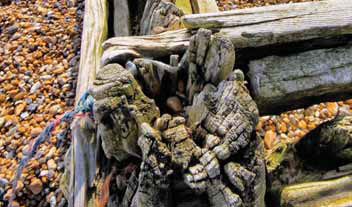Wood in water: The ultimate challenge
22 May 2018Gervais Sawyer looks at some of the challenges timber faces when in water.
You should be aware by now of the demands of using wood in Use Class 4 situations. “Make sure it’s 4” is the Wood Protection Association’s snappy slogan, and very necessary too because all too many merchants and their customers think that as long as the wood is described as pressure treated and is green, you can use it anywhere for anything.
Regrettably, much that is sold can at best hardly even be described as “pressure painted” and is quite unsuitable for UC4 in-ground applications.
Putting wood in the ground is very demanding because not only do you have soil that is packed full of bacteria, fungi and animals just looking for a carbohydrate meal, you also have lots of moisture that can leach out preservatives or the extractives that give some timbers their natural durability.
How much more demanding therefore is it to use wood in fresh water for bridges, revetments and even simply fencing? Lots of water gives maximum leaching effect. Fortunately, in the UK, bacteria and fungi are really the only challenge because there are no aquatic freshwater wood borers. So there is really only a choice between taking a treatable low durability timber and impregnating it with the specified loading and depth of penetration of preservative (not easy to achieve), or using a timber with high natural durability.
And then, there is using wood in salt water. It is almost the ultimate challenge, with maximum leaching, a wide variety of aggressive fungi and wood borers and possibly severe mechanical demands such as abrasion and shingle scour.
Where timber is permanently or partially immersed, fungi are not such a problem owing to lack of sufficient oxygen, but above water, decay can follow – marine piling often fails at the top. Where salt water wetting is intermittent by the tides, the major wood destroyer is gribble (Limnoria spp), which is most active between low and mid-tide. What it lacks in size is made up for in numbers. They rasp away the wood surface, which becomes so weakened that waves wash the damaged wood away, exposing fresh material. After a time piles get a narrowed waistline. Gribble is the major problem around our shores.
In many locations, timbers can be rapidly damaged by shipworm such as Teredo (all around our shores) and Lyrodus (around our southern shores). As estuaries have become less polluted, Teredo is returning in places and, in the Thames, Teredo has been observed as far up river as Woolwich.
We can be thankful that we live surrounded by relatively cool water, because in the tropics there are species that can damage even the most durable timbers. One organism, Sphaeroma, can bore into timber for a refuge such that it is has not been deterred by high loadings of CCA preservative, while Martesia has even been observed to tunnel through 10mm-thick hard polyurethane rubber.
Since the demise of CCA, we now have no preservatives approved for use in the marine environment other than creosote, so the only option is to use naturally durable species. Amongst the temperate species oak is really the only option.
Tropical species can meet the needs, but they should be used wisely, saving the highest performance timbers that are available in long lengths for situations where nothing else will do (greenheart, for example). Species with similar durability are available in shorter specifications and they can be used for braces and decking.
These difficulties have stimulated research into the suitability of using chemically modified timbers in the marine environment.
Lamination of suitable species into longer lengths is another option to be explored.
Timbers like greenheart are so durable that they can be salvaged when no longer needed and recycled/upcycled into new uses. As such, they can be fully FSC approved but will, of course, probably require strength grading.

